Wet-soil shrubs like Buttonbush, Black Chokeberry, Dogwood varieties, Virginia Sweetspire, and Elderberry create ideal natural barriers in soggy areas where other plants fail. These hardy options thrive in poor drainage conditions while providing dense foliage for privacy, attractive seasonal interest, and valuable wildlife habitat. You’ll benefit from their erosion control capabilities and adaptability to partial shade. The following selections offer perfect solutions for transforming problematic wet areas into beautiful, functional living fences.
Understanding Why Wet-Soil Shrubs Excel as Boundary Plants
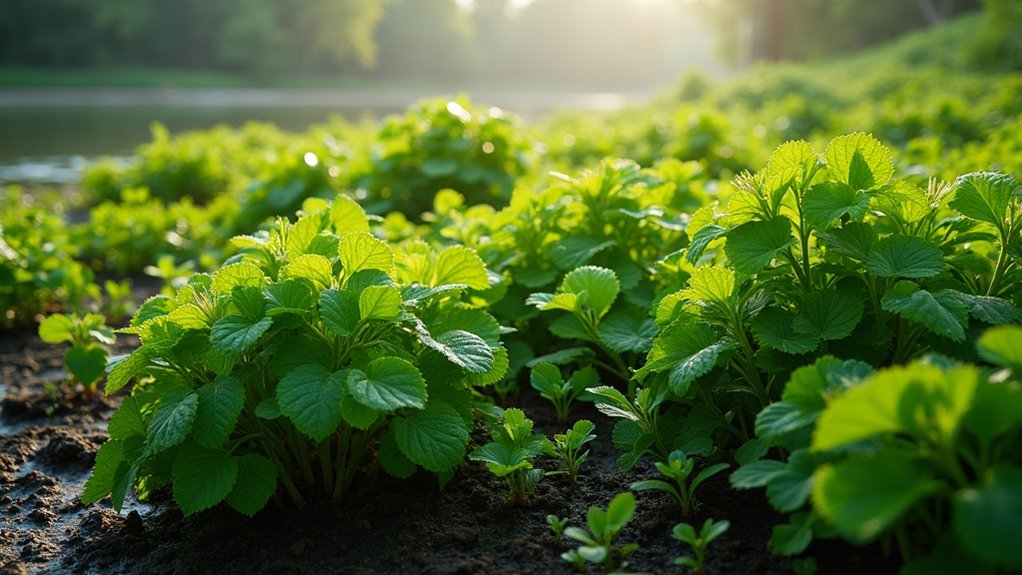
While many homeowners struggle to find effective plantings for problematic wet areas, wet-soil shrubs offer an elegant solution as natural barriers. These specialized plants thrive where others fail, developing robust root systems that stabilize soggy ground and prevent erosion.
What makes these shrubs truly exceptional as boundaries is their growth habit—they typically form dense thickets with green leaves in summer that create effective visual screens and noise buffers. Many varieties, like Black Chokeberry, produce attractive berries in late summer or fall, adding seasonal interest while providing food for local wildlife.
Beyond their practical benefits, these moisture-loving plants create ecological value by supporting pollinators and offering habitat for birds and beneficial insects, turning challenging wet soil into a thriving landscape asset.
Key Benefits of Using Moisture-Loving Shrubs for Property Lines
Because they combine practical function with ecological value, moisture-loving shrubs offer numerous advantages when used as property boundaries.
These wet-tolerant plants create effective screens while stabilizing soil in areas where other vegetation struggles. Your green barrier will naturally reduce erosion thanks to extensive root systems that manage water runoff in problematic wet zones.
Beyond practical considerations, these shrubs for wet conditions enhance your property’s biodiversity by attracting pollinators and birds.
Species like Black Chokeberry and Virginia Sweetspire provide dense foliage that blocks unwanted views and reduces noise from neighboring properties.
Many options, including Buttonbush and Ligularia, thrive in partial shade, making them versatile choices for various lighting conditions along your boundaries.
Their adaptability to poor drainage transforms problematic areas into beautiful, functional living fences.
Buttonbush: A Wildlife Magnet for Soggy Boundaries
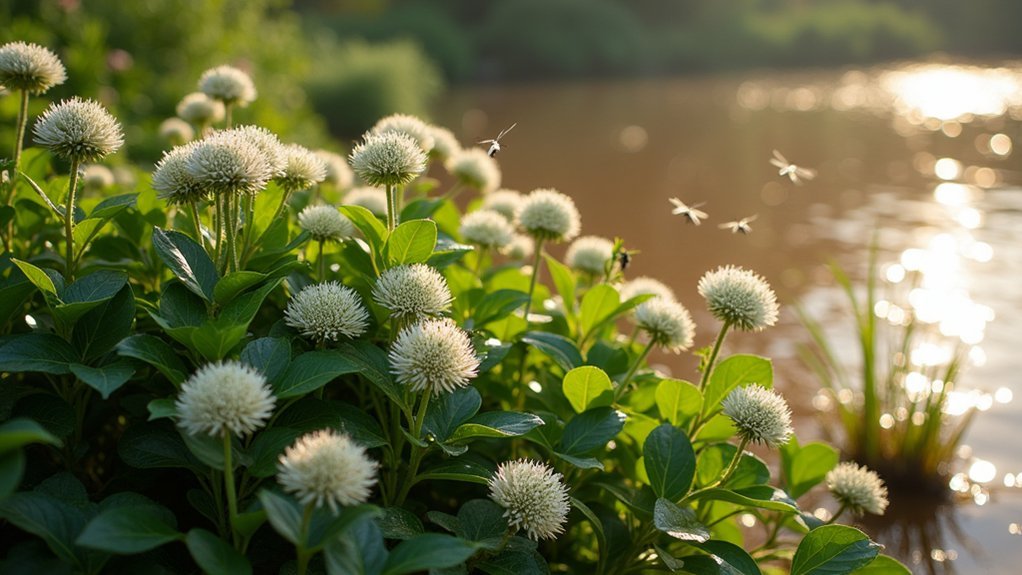
Among the excellent choices for wet boundaries, Buttonbush (Cephalanthus occidentalis) stands out as a remarkable wildlife attraction for persistently damp areas. This fast-growing shrub reaches 8-12 feet tall, creating an effective natural barrier that’s exceptionally tolerant of wet conditions, even thriving during occasional flooding.
The plant’s distinctive spherical flower clusters produce a sweet fragrance that attracts numerous pollinators, enhancing your garden’s biodiversity. After flowering, small red fruits develop, providing food for over 20 bird species.
- Native to the Chicago region, making it ecologically beneficial
- Supports diverse wildlife including bees, butterflies, and birds
- Available in compact varieties like Sugar Shack (3-4 feet tall) for smaller spaces
You’ll appreciate how this versatile shrub transforms problematic soggy boundaries into thriving wildlife habitats.
Black Chokeberry: The Four-Season Barrier Solution
Black chokeberry transforms your wet landscape boundaries with dramatic seasonal displays, from spring’s white flowers to autumn’s fiery red foliage and glossy black berries that persist into winter.
You’ll appreciate how this adaptable 3-6 foot shrub creates an effective privacy screen while simultaneously attracting diverse bird species to your garden.
The shrub’s ability to thrive in challenging wet conditions while providing year-round visual interest makes it an outstanding choice for homeowners seeking both functionality and beauty in their natural barriers.
Beauty Through Seasons
When searching for a wet-soil barrier that remains attractive year-round, you’ll find few options as versatile as the black chokeberry. This native shrub delivers visual interest in every season while thriving in challenging wet areas without complaint.
Your landscape benefits from:
- Spring transformation with clusters of delicate white flowers that attract essential pollinators
- Summer showcase of dark green leaves contrasting against developing berries
- Fall finale featuring stunning reddish-purple foliage that commands attention
While black chokeberry adapts well to poor soil conditions, you’ll achieve peak growth by adding organic matter before planting.
The plant’s adaptability to varying light conditions makes it perfect for those tricky locations in your yard that alternate between wet and dry throughout the seasons.
Birds will appreciate the glossy black berries that persist after summer ends.
Wildlife Magnet Capabilities
Beyond its aesthetic appeal, black chokeberry serves as a powerful wildlife attraction hub for your landscape. The glossy black fruits remain on branches long after other food sources disappear, creating a reliable buffet for local birds throughout changing seasons.
Unlike shrubs that falter in standing water, this versatile plant thrives in moisture-rich environments while also tolerating surprisingly dry conditions once established.
Spring’s creamy white flower clusters transform your barrier into a buzzing pollinator sanctuary, drawing bees and butterflies that enhance your garden’s biodiversity. As these beneficial insects increase, you’ll notice improved pollination throughout your entire landscape.
The dense growth habit provides nesting opportunities and protective cover for birds, creating a complete wildlife support system. This ecological benefit comes packaged with the practical advantage of a beautiful, functional barrier that serves multiple purposes.
Dogwood Varieties That Thrive in Water-Logged Soils

Waterlogged areas in your garden don’t have to remain barren or problematic. Dogwoods offer an elegant solution, with several varieties specifically adapted to thrive in saturated conditions while creating effective natural barriers.
Cornus sericea ‘Hedgerows Gold’ stands out with its:
- Variegated foliage that deepens beautifully in autumn
- Impressive height exceeding 2 meters when mature
- Ability to withstand consistently wet soil conditions
For another striking option, consider Cornus alba ‘Sibirica Variegata’, which features pink-purple fall coloration and dramatic red winter stems.
Both varieties can be pruned to control size and shape, making them perfect for creating living boundaries in challenging wet areas.
These dogwoods don’t just solve drainage problems—they’ll attract pollinators, provide habitat for birds, and enhance your garden’s biodiversity throughout the seasons.
Virginia Sweetspire: Creating Dense Natural Screens
For gardeners struggling with persistently wet soil conditions, Virginia Sweetspire emerges as an exceptional solution for creating privacy screens. ‘Henry’s Garnet’ cultivar reaches heights of 5 feet, forming a robust barrier that thrives in poor drainage and withstands occasional flooding.
| Feature | Benefit |
|---|---|
| Drooping white flowers | Adds fragrance and visual appeal in spring |
| Fall foliage colors | Provides orange, red, and yellow seasonal interest |
| Pollinator attraction | Enhances garden biodiversity with bees and butterflies |
You’ll appreciate how this versatile shrub evolves through multiple seasons, starting with fragrant flower clusters in late spring and culminating in a spectacular autumn display. Plant several in a row to establish an effective, wildlife-friendly barrier that turns your wet problem area into a garden highlight.
Summersweet: Fragrant Flowering Borders for Wet Areas

When landscape challenges include persistently damp soil, Summersweet (Clethra alnifolia) stands out as a magnificent solution for creating natural barriers that delight the senses. This adaptable shrub thrives where other plants struggle, converting problem areas into garden highlights.
You’ll appreciate Summersweet’s versatility in various light conditions, from full sun to partial shade, making it perfect for different sections of your property. Compact varieties like ‘Sixteen Candles’ and ‘Einstein’ create ideal 3-4 foot borders without overwhelming your space.
- Produces fragrant white flower clusters in late summer that attract butterflies and songbirds
- Offers multi-season interest with lush green summer foliage changing to vibrant fall colors
- Performs exceptionally well in wet, poorly-drained soils where many shrubs fail
Willow Species That Form Rapid Privacy Barriers
You’ll find willow species like the Hakura Nishiki transform wet, poorly drained areas into beautiful privacy screens within just a few growing seasons.
These adaptable shrubs offer flexibility in landscape design, thriving in flood-prone locations where many other plants would fail.
Their striking variegated foliage changes with the seasons, providing year-round interest while maintaining their practical function as a dense, natural barrier.
Fast-Growing Naturalized Varieties
Among the most efficient solutions for wet-soil privacy screens, willow species stand out as exceptional performers. The Hakura Nishiki Willow can reach an impressive 6-10 feet in a single growing season, making it perfect when you’re seeking quick results.
You’ll find these adaptable shrubs thrive in challenging wet conditions where other plants struggle.
What makes willows particularly valuable for your landscape:
- Their flexible branches allow for creative shaping and pruning to customize your privacy barrier
- They tolerate various soil types, including problematic heavy clay areas
- They attract wildlife, adding biodiversity benefits while creating your natural screen
You’ll appreciate how these naturalized varieties combine functionality with ecological benefits, transforming soggy areas into attractive, living borders that serve multiple purposes in your garden ecosystem.
Flexible Landscape Applications
Versatile in their adaptability, willow species offer homeowners numerous creative possibilities for addressing privacy concerns in wet landscapes. The Hakura Nishiki Willow (Salix integra) stands out as an exceptional choice, reaching impressive heights of 6-10 feet within just a few years.
You’ll find these willows thrive where other shrubs struggle—in persistently moist or flood-prone areas with high water tables. Their pliable branches allow you to easily shape and maintain them according to your specific screening needs.
Whether you’re creating a boundary between properties or blocking an unsightly view, you can customize your willow barrier to fit your space.
Beyond functionality, these fast-growing shrubs contribute aesthetic value with their attractive foliage, transforming problematic wet areas into visually appealing landscape features that serve double duty.
Seasonal Willow Features
Seasonal changes transform willows into dynamic privacy features that evolve throughout the year. The Hakura Nishiki Willow stands out with its variegated foliage that shifts to stunning pink and purple hues in autumn, adding visual interest to your natural barrier.
You’ll appreciate how willows adapt to your specific privacy needs:
- Achieve 6-10 feet of height in just a few years, providing quick screening solutions where you need them most.
- Thrive in problematic wet areas where other shrubs struggle, turning drainage issues into landscape advantages.
- Allow for customized shaping through flexible branches that can be pruned to your desired height and density.
For immediate privacy in wet conditions, willows offer the perfect combination of rapid growth, adaptability, and seasonal beauty.
Native Viburnums for Wet Boundary Plantings
Three outstanding native viburnum species offer ideal solutions for challenging wet boundary areas while creating effective natural barriers. Viburnum dentatum (Arrowwood) thrives in soggy conditions, growing 6-10 feet tall with dense foliage that creates privacy. Viburnum trilobum (Highbush Cranberry) combines boundary definition with visual appeal through spring flowers and fall fruits. Viburnum nudum (Possumhaw) brings fragrance and bird-attracting berries to wet property lines.
| Species | Height | Features | Wildlife Value |
|---|---|---|---|
| Arrowwood | 6-10′ | Dense branching | Shelter, nesting |
| Highbush Cranberry | 8-12′ | White flowers, red berries | Food for birds |
| Possumhaw | 6-12′ | Fragrant blooms, blue-black fruit | Attracts pollinators |
You’ll appreciate how these natives not only tolerate occasional flooding but actually stabilize wet soils while supporting local ecosystem health.
Elderberry: The Multi-Purpose Hedge for Damp Soils
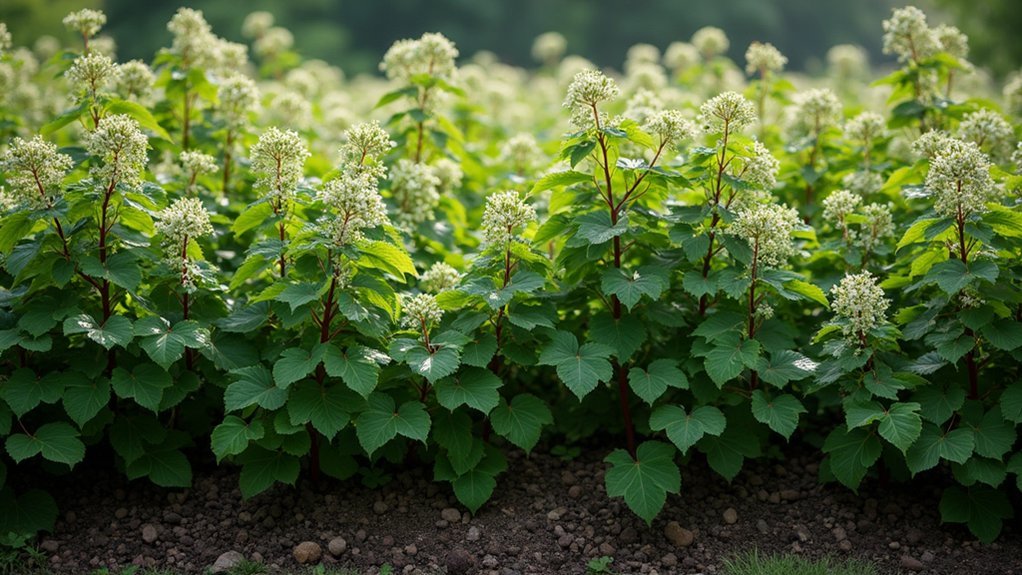
Among wetland-friendly shrubs for natural barriers, Elderberry (Sambucus) stands out as a remarkably functional choice that excels in soggy conditions where other hedging plants fail.
Growing 5-12 feet tall, this versatile shrub creates a dense privacy screen while its compound leaves up to 12 inches long provide lush greenery throughout the growing season.
You’ll appreciate elderberry’s multi-seasonal appeal and practical benefits:
- Clusters of delicate white flowers appear in late spring, attracting valuable pollinators to your garden
- Dark purple berries emerge by late summer, drawing birds and offering you harvesting opportunities for medicinal syrups
- Robust growth habit forms an effective windbreak and visual barrier without requiring dry soil conditions
This deciduous powerhouse combines ornamental value with ecological benefits, making it ideal for those challenging wet areas.
Winterberry: Colorful Year-Round Boundary Definition
Vibrant winterberry holly creates a stunning natural boundary that truly shines when other shrubs have lost their visual appeal. Growing 6-10 feet tall, this deciduous holly forms a dense barrier while thriving in the wet, acidic soils that challenge many other plants.
You’ll enjoy the spectacular display of bright red berries that persist throughout winter, providing essential food for birds when resources are scarce. For maximum berry production, plant both male and female specimens in proximity, as only females produce the colorful fruits.
While winterberry adapts to various conditions, it performs best in full sun to partial shade with consistently moist soil.
If you’re dealing with poor drainage or wetland areas in your landscape, you’ll find winterberry to be an ideal solution for both functionality and seasonal beauty.
Designing Effective Wet-Soil Hedge Configurations
Creating a thoughtful wet-soil hedge configuration extends beyond selecting individual shrubs like winterberry.
Designing effective wet-soil hedges requires thoughtful combinations of native shrubs beyond individual specimen selection.
You’ll want to combine native species such as Black Chokeberry and Gray Dogwood, which naturally thrive in soggy conditions while providing excellent screening.
For maximum effectiveness, consider these strategic approaches:
- Group shrubs according to moisture tolerance, placing those that prefer consistently wet soil in the most saturated areas.
- Incorporate flowering varieties like Summersweet and Virginia Sweetspire to attract pollinators while enhancing visual interest.
- Include fast-growing options such as Buttonbush to establish privacy barriers quickly.
Regular pruning of taller specimens like Gray Dogwood will maintain your desired hedge height while encouraging denser growth.
This thoughtful arrangement not only creates an attractive boundary but also establishes valuable wildlife habitat in your landscape’s wetter areas.
Maintenance Strategies for Thriving Moisture-Loving Barriers
While native wet-soil shrubs require less maintenance than traditional hedges, they’ll still need regular attention to flourish as effective barriers. Regular pruning of species like Black Chokeberry and Gray Dogwood maintains their shape and promotes healthier growth, enhancing their effectiveness as natural screens.
Incorporate organic matter into your planting area to improve drainage and nutrient availability for shrubs like Summersweet and Virginia Sweetspire. Space plants 3-5 feet apart to guarantee proper airflow and reduce resource competition.
Don’t overlook mulching around Buttonbush and Ligularia to retain moisture, suppress weeds, and stabilize soil temperature.
Since wet environments can harbor pests and diseases, regularly monitor your Perennial Hibiscus and Pink Turtlehead for early signs of trouble, allowing for prompt intervention.
Frequently Asked Questions
What Shrub Tolerates Wet Soil?
You’ll find several shrubs that tolerate wet soil: Black Chokeberry, Gray Dogwood, Summersweet, Virginia Sweetspire, and Buttonbush. They’re all excellent choices, with Buttonbush even thriving in flood conditions.
What Grows Best in Waterlogged Soil?
In waterlogged soil, you’ll find Black Chokeberry, Gray Dogwood, and Buttonbush thriving exceptionally well. Summersweet and Virginia Sweetspire also flourish in these conditions, while Ligularia adapts beautifully to shaded wet areas.
What Is the Best Hedge for Soggy Soil?
For soggy soil, you’ll find Black Chokeberry makes an excellent hedge with its glossy fruit. Don’t overlook Summersweet, Virginia Sweetspire, Buttonbush, and Gray Dogwood—they all thrive in wet conditions while creating effective natural barriers.
What Plants Love Soggy Soil?
You’ll find Black Chokeberry, Virginia Sweetspire, Summersweet, Gray Dogwood, and Buttonbush thrive in soggy soil. They’re adaptable plants that don’t just tolerate wet conditions but actually flourish in moisture-rich environments.
In Summary
You’ll find wet-soil shrubs make excellent natural barriers for those challenging damp areas where other plants fail. From buttonbush to winterberry, these moisture-loving options provide privacy, wildlife habitat, and year-round interest while requiring minimal maintenance. Choose varieties that match your specific conditions, plant them in staggered rows for maximum density, and you’ll enjoy a thriving, functional boundary that turns problem areas into landscape assets.

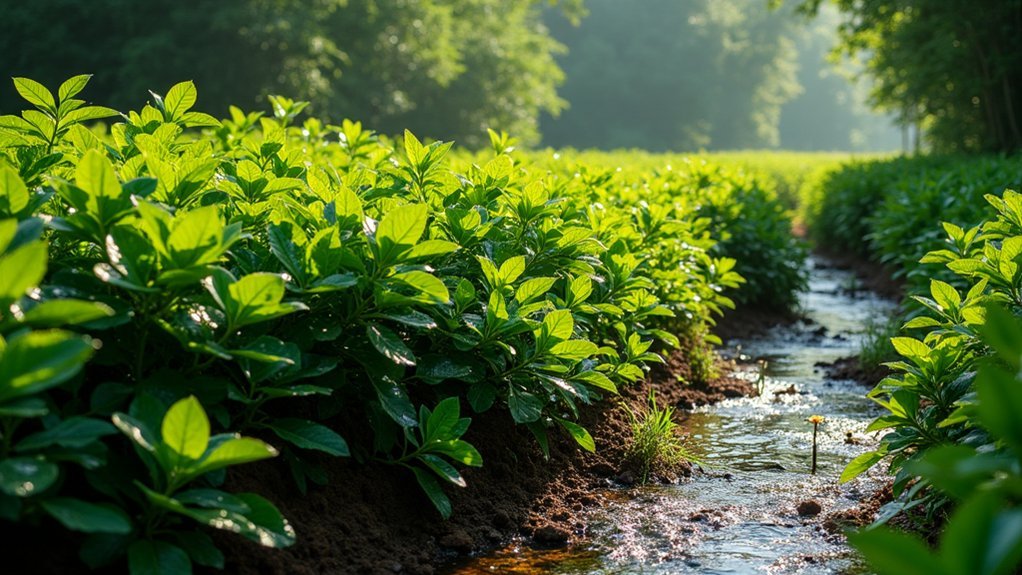

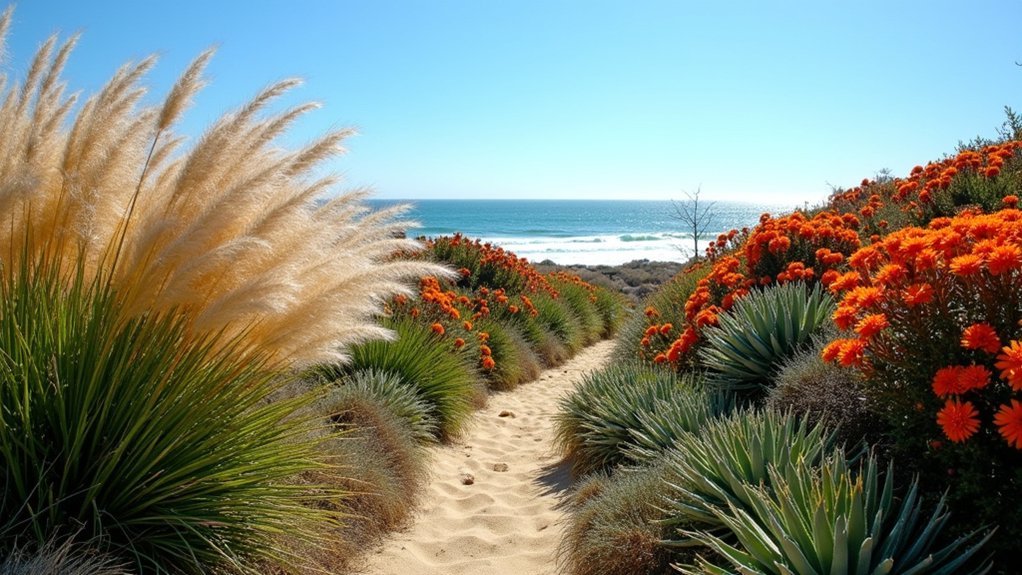
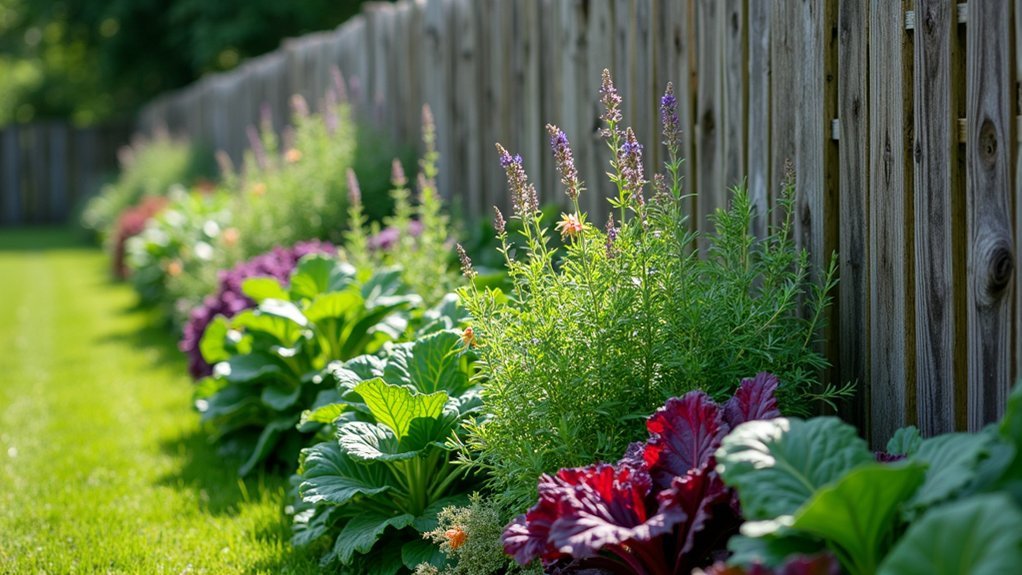
Leave a Reply